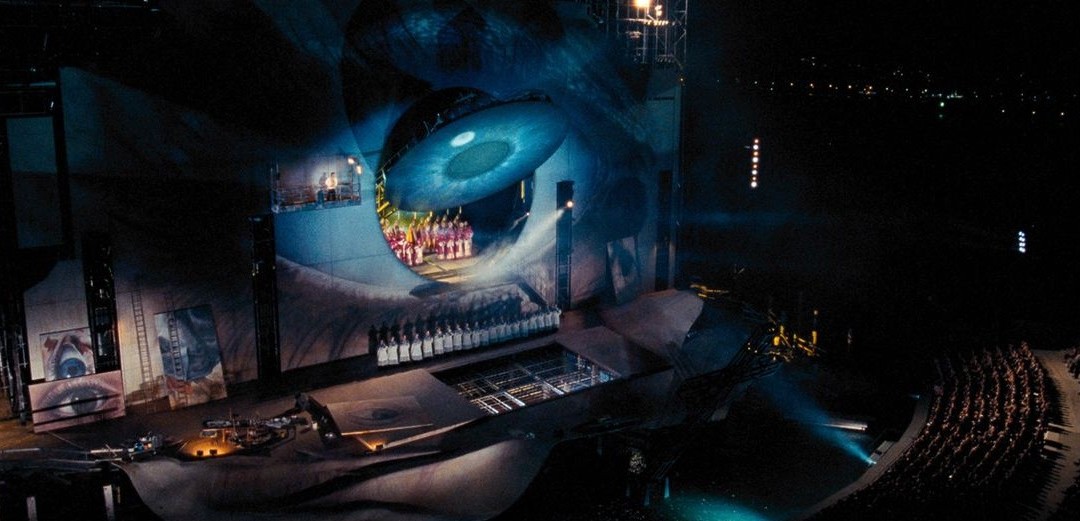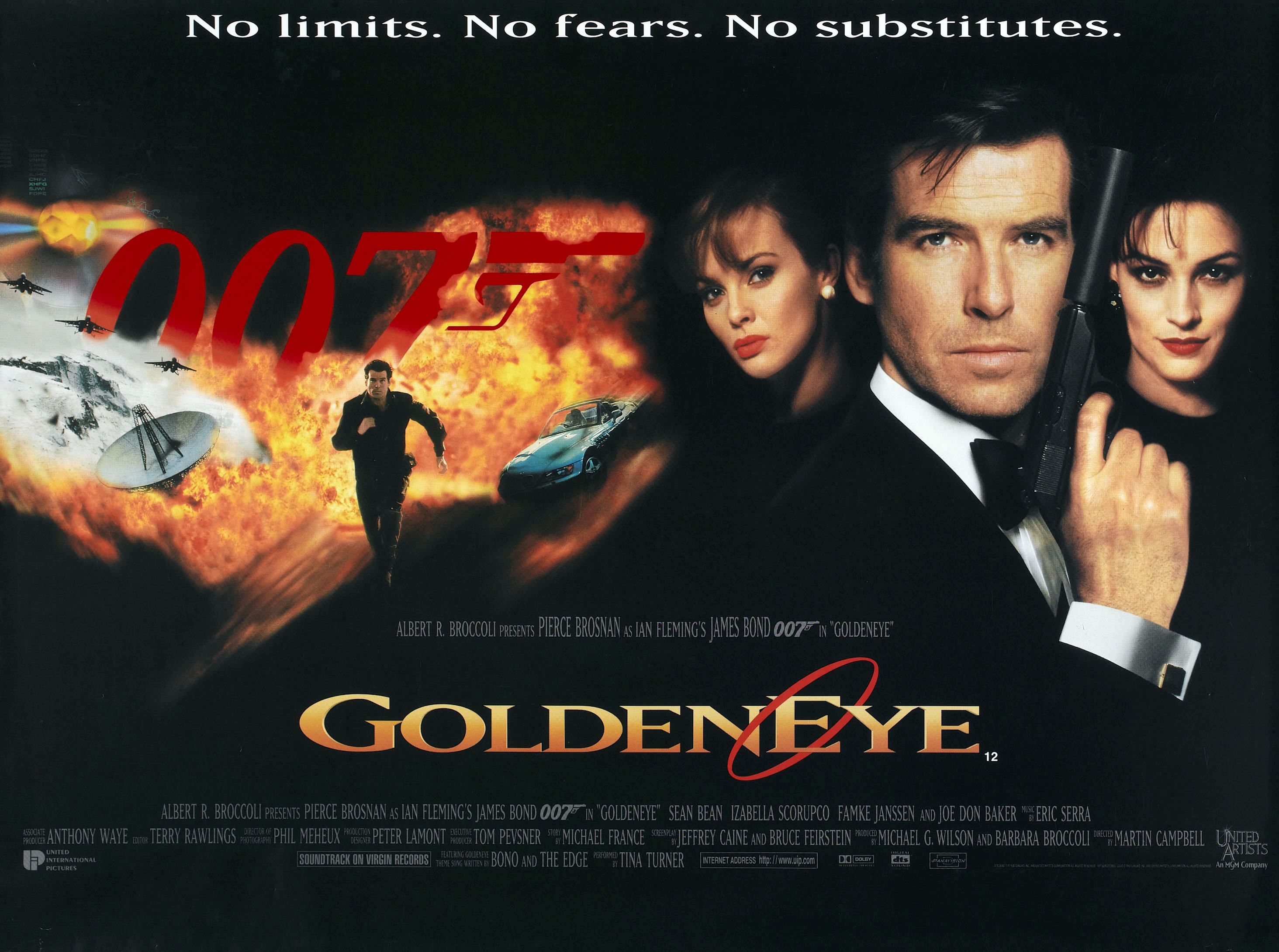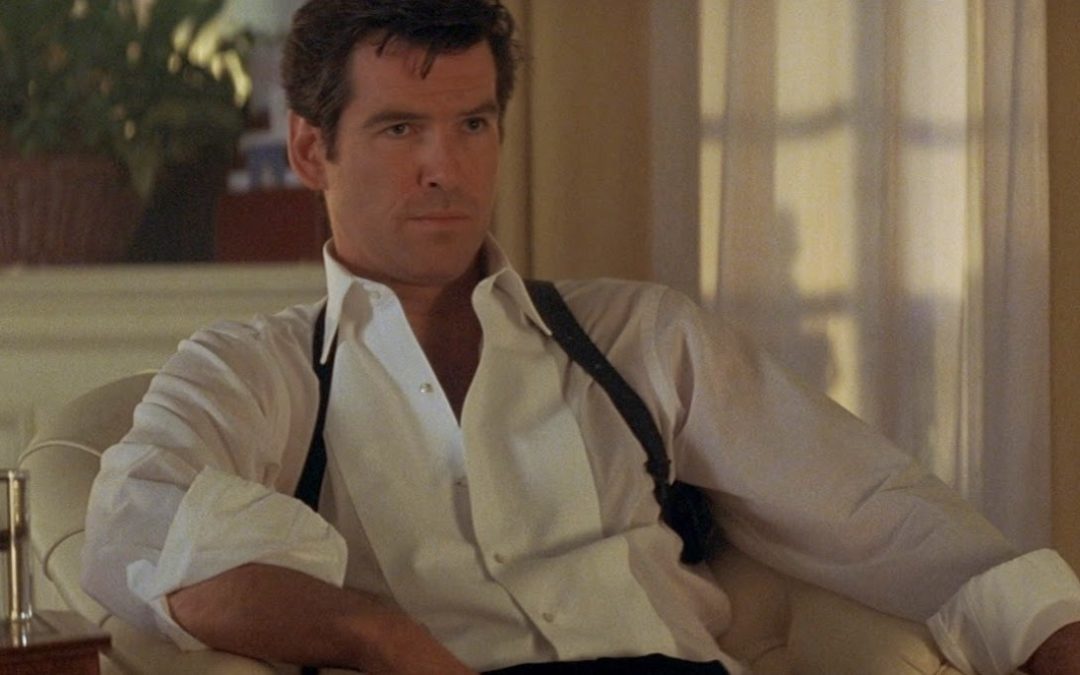
by 007hertzrumble | Mar 25, 2014 | #Bond_age_ Project, The World Is Not Enough
This is the 19th essay in a 24-part series about the James Bond cinemas co-created by Sundog Lit. I encourage everyone to read the other essays, comment and join in on the conversation about not only the films themselves, but cinematic trends, political and other external influences on the series’ tone and direction.
Of [In]human #Bond_age_ #19: The Tragedy of The World Is Not Enough: Shakespeare and a Sewer of Misogyny
by James David Patrick

“Something is very wrong with the way American women are trying to live their lives today… [T]he problems and satisfaction of their lives, mine, and the way our education has contributed to them, simply did not fit the image of the modern American woman as she was written about in women’s magazines, studies and analyzed in classrooms and clinics, praised and damned in a ceaseless barrage of words ever since the end of World War Two. There was a strange discrepancy between the reality of our lives as women and the image to which we were trying to conform, the image that I came to call the feminine mystique.”
-Betty Friedan, The Feminine Mystique
“There’s daggers in men’s smiles.”
-William Shakespeare, Macbeth Act II, Sc. III
There’s a temptation to reduce The World Is Not Enough and Die Another Day into one ghastly entity, a turn of the century mistake. I even considered distilling both films into one entry in the #Bond_age_ essay project, focusing on how pandering to the audience through nostalgia and cinematic shorthand can go ever so horribly wrong. I thought this would save sanity. Doing so, however, would be a disservice to TWINE and a marginalization of the DAD’s scourge of terror. First of all, I owe myself a full essay to vent my frustrations, to detail the ways in which Die Another Day curdles the entire Brosnan era and tarnishes Bond for a whole generation of fans. Second, in order to fully appreciate (and perhaps loathe) the ways in which The World Is Not Enough both uses and abuses the Bond formula, we must use a scalpel to peel back the layers of rabble and hyperbole and cut right to the gooey innards. Only then can we dissect what makes that movie tick, what makes it at once more interesting and more loathsome than the average mid- (or bottom-) tier Bond movie.
I first confronted the issue of feminism in James Bond in my discussion about the rape of Pussy Galore in Goldfinger. Ultimately I concluded that the treatment of Pussy Galore was born out of the confused sexual politics of the early 1960’s and the Bond filmmakers’ need to up the titillation factor with each successive Bond film. Again, I stress this does not excuse the questionable abuse, merely provide context and history that could produce a narrative miscalculation, a miscalculation that appears to our eyes brutish and Cro-Magnon. In the 48 years since Goldfinger, the James Bond series has received more than its share of criticism for the treatment and hypersexualization of women, some of it fair, some of it shortsighted and cribbed from hearsay and reputation.
Women threw themselves at Connery after merely a glance, even when they played pro-active roles in the drama. On Her Majesty’s Secret Service remains an outlier – Bond giving himself wholly to a strong, independent woman who also happens to save his skin. Moore had to work (slightly) harder at his womanizing – a quip and a seductive eyebrow. During the Moore years, the series even attempted to place a few of Bond’s female counterparts as de facto equals, in between the 1970’s serial bimboism, of course. Bond became a one-woman (per movie) monogamist during the Dalton years, a direct result of the newly widespread fear of AIDS. GoldenEye presented a mission statement on the ways women would be treated in the Brosnan years – strong, independent, occasionally in-charge, and skeptical of James Bond’s charms. Flash forward four years to The World Is Not Enough and the certainty of this thesis becomes murky and confused, like the enveloping darkness of the facepalm through which you’re forced to watch every line spoken by Dr. Christmas Jones. (more…)

by 007hertzrumble | Feb 4, 2014 | My Favorite #Bond_age_, Quantum of Solace
Fools Gold and Pools of Blue: Color Symbolism in Quantum of Solace
by Array Jackson (@ArrayJackson)

Beyond the surface is my unknown
I could fall
and fall
and fall
But could I reach the elusive destination?
If I stepped inside would I ever know I was there?
Is it possible to transcend
to crack the surface
to submerge the impenetrable barrier
Into your vibrant pools of blue…
My love letter to Daniel Craig ~ Array Jackson
I can’t get the image out of my head. Larger than life. Vast. Deep. Breathtaking… The most amazing shade of blue. Can it be only a coincidence? I don’t think so. I’m flooded with theories about Quantum of Solace.
I honestly can’t remember if I saw Quantum of Solace in the theater; it’s more likely I first picked up bits and pieces on cable. So when I sat down to watch it in preparation for this essay, I knew I’d already seen something of it, and unfortunately I’d heard a lot—a whole lot of negative. But I went into this project positive, determined I was going to find something in the film of immense richness, digging below the surface if necessary. If you will, I was questing for gold. And I found it. As a matter of fact about a quarter of the way into the film I was overwhelmed with gold. And then black. And suddenly that vibrant, poetic blue. I asked myself: what the heck does all this bold color have to do with the plot? My ultimate answer: everything. (more…)

by 007hertzrumble | Jan 31, 2014 | #Bond_age_ Project, Tomorrow Never Dies
This is the 18th essay in a 24-part series about the James Bond cinemas co-created by Sundog Lit. I encourage everyone to read the other essays, comment and join in on the conversation about not only the films themselves, but cinematic trends, political and other external influences on the series’ tone and direction.
Of [In]human #Bond_age_ #18: Chekhov’s Gun and Q Branch Expectation and Narrative in Tomorrow Never Dies
by James David Patrick

“If you say in the first chapter that there is a rifle hanging on the wall, in the second or third chapter it absolutely must go off. If it’s not going to be fired, it shouldn’t be hanging there.”
Anton Chekhov’s oft-cited dramatic principle has become the fiction writer’s favorite mantra. Thoughtful aunts have cross-stitched the phrase onto throw pillows and wall hangings. Those wall hangings hang next to MFA degrees and ornate lithographs of Ernest Hemingway’s ever popular “The first draft of everything is shit.”
In addition to his plays and short stories, Chekhov was also a prolific letter writer. And it was in a November 1889 letter to Lazarev-Gruzinsky, a one-time collaborator, that he first detailed the “Chekhov’s Gun” theory – though he lacked the foresight and egotism to dub it such upon conception. The principle functions as a reminder to every would-be writer about the importance of brevity and managing audience expectation. Chekhov uses a gun, an inherently dangerous item, in his example specifically because it solicits an audience’s immediate attention. Attention breeds expectation. Expectation can be skillfully usurped (a red herring) or met (the firing of the gun), but not ignored. The gun must be literally or symbolically fired. (more…)

by 007hertzrumble | Jan 13, 2014 | My Favorite #Bond_age_
Sex for Dinner and Death for Breakfast: Why Die Another Day Deserves Another Look
by Michael Cavacini (@MCavacini)

In 2002, I saw my first James Bond movie in a theater, Die Another Day, which was the 20th in the series and marked the 40th anniversary of the 007 film franchise. Despite the negative reviews, Die Another Day is still one of my favorite James Bond films. Before you change the channel, give me a chance to explain.
Die Another Day was Pierce Brosnan’s fourth foray as 007, and in this film he seemed extremely comfortable in the role. He oozed charisma, delivered humorous one-liners with aplomb and panache and stole the show during a spectacular sword fight with the film’s villain, Gustav Graves. (more…)
![From the Ashes: The Twisty Tale of GoldenEye’s [Un]certain Success](https://thejamesbondsocialmediaproject.com/wp-content/uploads/2018/02/goldeneye-pre-1080x675.jpg)
by 007hertzrumble | Dec 16, 2013 | #Bond_age_ Project, GoldenEye
This is the 17th essay in a 24-part series about the James Bond cinemas co-created by Sundog Lit. I encourage everyone to read the other essays, comment and join in on the conversation about not only the films themselves, but cinematic trends, political and other external influences on the series’ tone and direction.
Of [In]human #Bond_age_ #17: From the Ashes, The Twisty Tale of GoldenEye’s [Un]Certain Success
by James David Patrick

Although the popularity of the Bond franchise has endured 50 years, that popularity has not been without its share of crescendos and diminuendos, ebbs and flows and disappearances. The critical mass has called for the series’ demise on a number of occasions, and MGM’s ongoing financial crisis has regularly thrown monkeywrenches into the gears of the finely tuned machine. The six-year delay after Licence to Kill led many fans to believe that Bond had officially retired after going off the reservation in Licence. Disillusioned by the bureaucracy, the agent formally known as 007 living out the remaining years of his life running a bail bonds/chicken wing joint in Jamaica. But what transpired during that dark, uncertain time period may have actually revived the franchise.
Licence to Kill tanked at the box office. Perhaps as a result of the drastic tonal shift, perhaps as a result of box-office competition from a jam-packed multiplex. Licence opened on July 14th, 1989, drawing only $13 million that week and finishing fourth at the box office behind Batman (total gross: $251 million), Lethal Weapon 2 (total gross: $147 million) and Honey, I Shrunk the Kids. Ghostbusters II, released the month prior, pulled almost $7 million… and Indiana Jones and the Last Crusade, two months after it’s release, earned $7.38. By the week of August 4th -10th, LtK had dropped out of the Top 10, trailing all of the aforementioned movies except Ghostbusters II. Adjusted for inflation, the film’s return ranks dead last among Bond films, and Dalton’s other effort, The Living Daylights, bests only A View to a Kill and Licence to Kill. I wouldn’t be too quick to demonize The Smolder just yet, however. The bottom four Bond movies ranked by adjusted gross were all released during the 1980’s. It wasn’t that moviegoers had necessarily disconnected with Timothy Dalton (though he regularly plays the patsy); moviegoers had just disconnected with Bond altogether. The rise of the blue-collar action hero shoved our dapper spy back into the shadows. The new guard, the John McClanes and Martin Riggses, average Joes who woke up one day with their localized world falling apart, latched onto a zeitgeist and dominated the domestic box office. (more…)

by 007hertzrumble | Dec 11, 2013 | My Favorite #Bond_age_
Chest Hair Never Dies: Brosnan Borrows the Best of Bonds
by Keith Bodayla (@theactualkeith)

I may be biased since Tomorrow Never Dies was my first Bond film in the theaters, but Pierce Brosnan is the “Perfect Bond” in Tomorrow Never Dies. For the purposes of this writing, “perfect” does not mean “without flaws.” It means: “the right combination of his previous incarnations.” Through #Bond_age_, I have learned that everyone has a favorite Bond and everyone has reasons for disliking – even hating – the rest. Tomorrow Never Dies is the best combination of all the previous Bonds. It’s the Perfect Bond movie because there is something for every fan.
Action from the opening moments in the arms bazaar. The scene was originally meant for Timothy Dalton’s The Living Daylights, but was scrubbed from that movie. Dalton was a younger Bond that enhanced the action with bigger and better stunts. It was mostly a byproduct of 1980’s moviemaking, but that’s what differentiated Dalton’s Bond from what had come before. Up until him, the most noteworthy stunt was the javelin jump in The Man With The Golden Gun. With Brosnan they maintained that Dalton-level action, and Tomorrow Never Dies is the perfect balance of improbability and realism without being too outlandish (see Die Another Day).
The only part of Tomorrow Never Dies that borders on the outlandish is the villain. Jonathan Pryce is a bit over the top in his performance as Elliot Carver, but for most of the movie it works. Carver continues the tradition of eccentric Bond villains/profiteers – a staple of the Roger Moore films (see Kananga in Live and Let Die, Scaramanga in The Man With The Golden Gun, Max Zorin in A View to a Kill etc.). Thankfully, they don’t give Carver a specific, defining quirk like the fact that he just really likes gold. He is simply a greedy man with a Blofeld-ian level of control (via the worldwide media) over world leaders and events. Carver is seen talking to members of his inner-circle via video phone, a scene reminiscent of the SPECTRE meetings only with far fewer spontaneous executions. Carver’s most over-the-top scene takes place when he mocks Wai Lin’s martial arts techniques, but somehow the talented actor Pryce manages to preserve the moment with his following line: “Pathetic.”
The villain proves not to be the only thing here for the Moore fan (and I hear there are many of you among us). Brosnan pulls off, quite spectacularly, the humor that was missing in the Dalton films. Sure the one-liners had always remained, but with Moore it was different. He was funny. He knew he was part comedian and not just a grim wiseacre. The defining moment of Moore’s brand of Bond comedy has to be when he drives the car out of the water, rolls down the window of the Lotus submarine and drops a fish out onto the beach. Brosnan is the only other guy I could see making that work. Moore and Brosnan’s Bonds are the only ones that seem to be having fun on the job. Sure it’s a mission and a paycheck, but they enjoy the day-to-day grind, too. If you doubt this, just watch Brosnan’s face as he drives the remote-controlled BMW through the parking garage. Despite the gunfire and danger, he’s having a blast.
Brosnan even borrows from Connery’s Bond. Connery played 007 as a real man’s man who objectified women on an hourly basis – certainly the “misogynist dinosaur” referenced by M in GoldenEye. In Tomorrow Never Dies though, we do get a bit of Connery’s swagger from Brosnan when he doesn’t hesitate to use Paris Carver to get to her husband. Brosnan, like Connery, also undermines the abilities of the women he runs into on his mission. He spends a good portion of the movie doubting Wai Lin’s utility only eventually acquiescing when he witnesses her physical prowess and acuity under pressure. You know this is still the 1990’s, however, because Brosnan does eventually catch on, whereas Connery would belittle her (probably on a seafaring vessel) well into the credits.
Also, on the topic of Connery, shortly after a glimpse of the Aston Martin DB5, Tomorrow Never Dies gives us a view of the only other chest hair in the series that could hold a candle to Connery’s. Sure, no one’s a Connery fan because of the chest hair, but someone’s got to tackle that hard-hitting journalism.
Tomorrow Never Dies also offers us something we haven’t seen in a while: a Bond with emotion. After his one-nighter with Paris Carver, she winds up dead. When Bond finds the body, he appears genuinely heartbroken. He doesn’t quite show some Lazenbies from On Her Majesty’s Secret Service, but, if only for a brief moment, Bond has a heart. He might not care about every notch on his bedpost, but occasionally he admits, through a look or a glance, that this one meant something. Paris Carver was that woman at some point in his past. Her death affected him. That emotion quickly gives way to anger and a need for revenge, a driving force for many other Bonds, especially Dalton.
There’s one Bond that hasn’t been mentioned yet, and he is the Bond that proves the theory. Daniel Craig’s Bond is very different from all the Bonds before him. Whether you consider Casino Royale an actual reboot of the franchise, it stands out as a change in direction and tone for the films. Realism and grittiness took over, largely inspired from the success of the Bourne franchise. We don’t see these trademarks in Tomorrow Never Dies, because it was still part of the old school, when women were easier, things were a little more outrageous, villains a little more over-the-top, and Bond was a little more lighthearted. Tomorrow Never Dies encapsulates everything we loved and still love about Bond, before the world made it necessary for Bond to get a little more intense and a little more real. And, of course, before Bond jumped the shark (probably while windsurfing) in Die Another Day.
Keith Bodayla is a writer and podcaster. He co-hosts the NSFW, But You’re Wrong (http://www.keithbodayla.com/butyourewrong) and the SFW, Living Room Theatre (http://www.keithbodayla.com/livingroomtheatre).
First Bond Movie: Either Dr. No or Goldfinger on VHS. Tomorrow Never Dies on screen
Favorite Bond Actor: Daniel Craig (Edged out Brosnan based on consistency)
Favorite Bond Girl: Brunette: Eunice Grayson. Blonde: Britt Ekland
How I Discovered #Bond_age_: Twitter invite to join in on the original Thunderball session.









![From the Ashes: The Twisty Tale of GoldenEye’s [Un]certain Success](https://thejamesbondsocialmediaproject.com/wp-content/uploads/2018/02/goldeneye-pre-1080x675.jpg)


